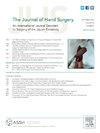Establishing a Murine Model of Muscle Changes in Chronic Nerve Compression
IF 2.1
2区 医学
Q2 ORTHOPEDICS
引用次数: 0
Abstract
Purpose
We aimed to build upon a previously validated model of early chronic nerve compression (CNC) by evaluating changes in gross muscle weight, muscle gene expression, and muscle function, and correlating the mechanism and timing of muscle- and nerve related changes.
Methods
Chronic nerve compression was induced by placing a Silastic tube around the sciatic nerve with the contralateral limb as control. At 6, 8, and 12 weeks of compression, gait analysis, muscle force measurements, and electrodiagnostics (EDX) were performed, and the sciatic nerve, tibialis anterior (TA), extensor digitorum longus (EDL), and gastrocnemius were harvested. Muscle weight (MW), cross-sectional area (CSA), g-ratio, axon area, and axon density were measured. Reverse transcripton polymerase chain reaction of TA+EDL muscle was performed. Genes assayed included atrogenes (Foxo-3, Atrogin-1, and MuRF1), markers of myogenesis (MyoD and MyoG), fatty acid synthase, type-I collagen (Col1a1), and inflammatory markers (tumor necrosis factor-α and interleukin-1β).
Results
At 6 weeks, we observed a maximum 30.8% decrease in nerve conduction speed. G-ratio was increased 14.4% at 8 weeks, and at all time points, we observed a 25%–26% decrease in axon area. At 12 weeks, we observed a 10.4% decrease in TA+EDL MW, and at 8 weeks, CSA was reduced 13.9%. At 8 weeks, expression of atrogenes was increased 2–3-fold implying ongoing atrophy. MyoD/MyoG expression was reduced 0.3 times, and fatty acid synthase, type-1 collagen, and inflammatory marker expression was increased 1.3-, 1.4-, and >2-fold, respectively. There were no clinically important differences in gait analysis or muscle force measurement between compressed and control limbs at any time-point.
Conclusions
The murine model of muscle changes in CNC demonstrates reduced nerve conduction speed, demyelination, and a shift in axon size consistent with early CNC. Changes in MW, CSA, and gene expression occur in the absence of significant differences in muscle function.
Clinical relevance
These findings establish a mouse model of early muscle changes in CNC that can be used to investigate interventions to reduce or delay muscle changes in compression neuropathies.
慢性神经压迫小鼠肌肉变化模型的建立。
目的:我们旨在通过评估总肌肉重量、肌肉基因表达和肌肉功能的变化,以及肌肉和神经相关变化的机制和时间,建立早期慢性神经压迫(CNC)模型。方法:以对侧肢体为对照,在坐骨神经周围置入硅胶管诱导慢性神经压迫。在压迫6、8和12周时,进行步态分析、肌肉力测量和电诊断(EDX),并采集坐骨神经、胫骨前肌(TA)、指长伸肌(EDL)和腓肠肌。测定肌肉重量(MW)、横断面积(CSA)、g比、轴突面积和轴突密度。对TA+EDL肌进行逆转录聚合酶链反应。检测的基因包括萎缩基因(Foxo-3、atrogin1和MuRF1)、肌生成标志物(MyoD和MyoG)、脂肪酸合成酶、i型胶原(Col1a1)和炎症标志物(肿瘤坏死因子-α和白细胞介素-1β)。结果:在6周时,我们观察到神经传导速度最大下降30.8%。8周时G-ratio增加14.4%,各时间点轴突面积均减少25% ~ 26%。在12周时,我们观察到TA+EDL MW下降10.4%,在8周时,CSA下降13.9%。8周时,萎缩基因的表达增加2-3倍,表明萎缩仍在继续。MyoD/MyoG表达减少0.3倍,脂肪酸合成酶、1型胶原蛋白和炎症标志物表达分别增加1.3倍、1.4倍和2倍。在任何时间点,受压肢和对照肢之间的步态分析或肌肉力测量均无临床重要差异。结论:小鼠CNC肌肉变化模型显示神经传导速度降低,脱髓鞘,轴突大小变化与早期CNC一致。MW、CSA和基因表达的变化发生在肌肉功能没有显著差异的情况下。临床意义:这些发现建立了CNC早期肌肉变化的小鼠模型,可用于研究减少或延迟压迫性神经病肌肉变化的干预措施。
本文章由计算机程序翻译,如有差异,请以英文原文为准。
求助全文
约1分钟内获得全文
求助全文
来源期刊
CiteScore
3.20
自引率
10.50%
发文量
402
审稿时长
12 weeks
期刊介绍:
The Journal of Hand Surgery publishes original, peer-reviewed articles related to the pathophysiology, diagnosis, and treatment of diseases and conditions of the upper extremity; these include both clinical and basic science studies, along with case reports. Special features include Review Articles (including Current Concepts and The Hand Surgery Landscape), Reviews of Books and Media, and Letters to the Editor.

 求助内容:
求助内容: 应助结果提醒方式:
应助结果提醒方式:


